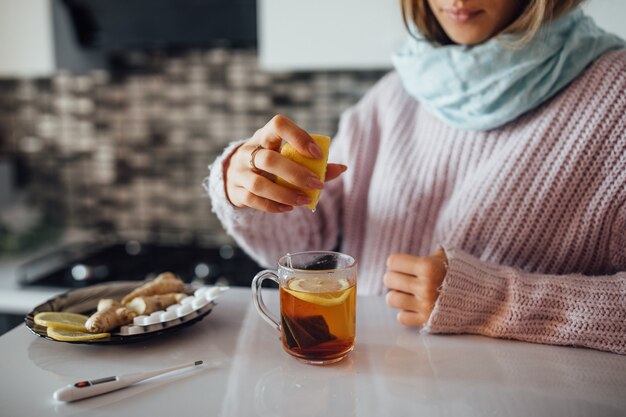
A yeast infection called Candida is caused by a type of microscopic fungi or yeast known as Candida albicans. This can affect various parts of the body, including the vagina, areas under the breast, lower abdomen, nail bed, and even beneath skin folds. Yeast infections can be painful and are often characterized by burning sensations, itching, and other uncomfortable symptoms. Factors that can increase the risk of yeast infections include stress, pregnancy and childbirth, chronic health problems, diabetes, use of steroids, oral contraceptives, and antibiotic medication.
Women may also experience yeast infections following menopause due to decreased estrogen levels, which cause the vaginal walls to thin. Yeast infections are common, and most women will experience at least one in their lifetime. Here are some simple home remedies to treat yeast infections.
**Signs of a Yeast Infection**
The first signs of a yeast infection often include intense itching and burning, particularly during urination or sex. It is advisable to avoid penetrative sex when experiencing a yeast infection. Another common symptom is a thick, odorless discharge resembling cottage cheese, often occurring a week or so before the menstrual cycle.
If you suspect a yeast infection, visit a doctor for a professional diagnosis, especially if you are pregnant. Keeping the condition at bay involves maintaining good personal hygiene, such as changing underwear daily, using unscented soap, rinsing thoroughly to avoid residue, and wiping from front to back when using the toilet. Wearing cotton underwear and avoiding tight-fitting clothes can also help prevent yeast infections.
**Home Remedies for Yeast Infection**
1. **Probiotics**
– Supplements with probiotics help maintain a healthy balance of microbes, reducing the chances of yeast overgrowth.
2. **Yogurt**
– Plain yogurt with live cultures (lactobacillus acidophilus) can combat yeast infections. Apply it externally to reduce itching or consume it to restore the body’s natural flora and pH balance.
3. **Coconut Oil**
– Apply coconut oil to the affected area three times daily due to its antifungal properties. It can also be mixed with cinnamon oil for additional benefits.
4. **Apple Cider Vinegar**
– Drink a mixture of 2 tablespoons of organic apple cider vinegar and warm water twice a day. You can also dilute it and apply it topically or use in a bath.
5. **Garlic**
– Garlic has natural antifungal and antibacterial properties. Apply crushed garlic topically or use diluted garlic oil mixed with vitamin E and coconut oil.
6. **Cranberries**
– Cranberry juice or tablets can help treat yeast infections due to their antibacterial and antifungal properties.
7. **Boric Acid**
– Boric acid capsules or a topical solution can help treat yeast infections but should not be used during pregnancy. Consult studies for the correct dosage as it is safe and effective.
8. **Tea Tree Oil**
– Dilute tea tree oil with water or mix it with olive/sweet almond oil and apply it topically. Not recommended for pregnant women.
9. **Oregano Oil**
– Dilute oregano oil with olive oil before applying. It can also be taken orally for quick results.
10. **Calendula**
– Topical application of crushed calendula leaves or calendula tea can treat yeast infections.
11. **Olive Leaf Extract**
– Effective due to its antioxidant, antiviral, and anti-inflammatory properties. Prepare and store a tincture for use.
12. **Basil, Thyme, Rosemary**
– Basil tea or steeped rosemary and thyme can be used as topical applications.
13. **Healthy Diet**
– Avoid dairy, processed foods, white flour, and sugar. Ensure intake of vitamins and supplements.
14. **Gentian Violet**
– Available in pharmacies, it can be applied topically.
15. **Pau d’Arco**
– This South American herb can be consumed or applied topically.
16. **Dry, Loose Clothing**
– Wearing loose, dry clothing helps prevent yeast infections by reducing warmth and moisture.
17. **Slippery-Elm Powder and Aloe Vera**
– These can be applied topically to relieve itching.
**Yeast Infections: More Info**
Yeast infections are not considered sexually transmitted diseases. Even women who are not sexually active can get yeast infections, though they can be spread through sexual contact. Symptoms include vaginal itching, inflammation, painful urination or intercourse, and unusual discharge. Various factors can disrupt the natural balance of bacteria in the vagina, such as antibiotics, pregnancy, weak immune systems, poor diet, and hormone imbalances.
**Diagnosis and Treatment**
Doctors usually diagnose yeast infections through medical history and a pelvic exam. Simple infections can be treated with over-the-counter antifungal creams or suppositories, and prescribed medication like fluconazole. Complicated infections may require longer treatment or specific medications. Regular checkups and gynecologist visits are important for maintaining good reproductive health.